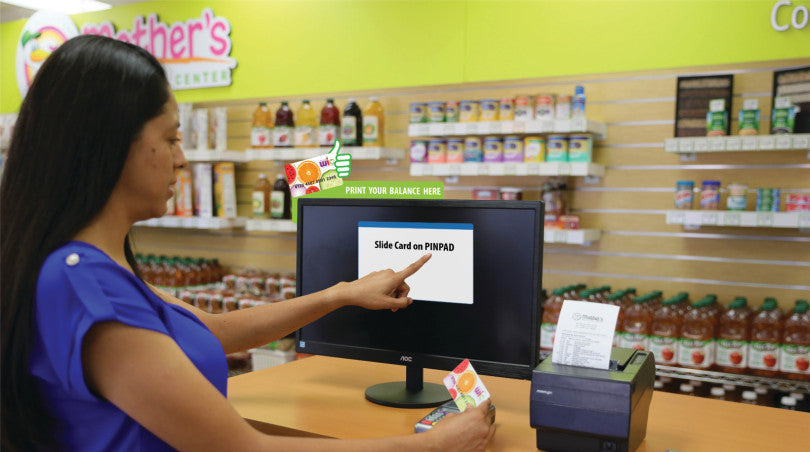Debit cards replace paper checks to ease shopping, reduce stigma, in government-funded nutrition program

The Women, Infants and Children program gets a long-awaited upgrade in California.
California residents who receive money for food through the Women, Infants and Children Supplemental Nutrition Program are now getting electronic cards instead of the cumbersome paper vouchers they’ve shopped with since the program’s inception in 1974.
The federal program, better known by the acronym WIC, helps feed more than 1 million people statewide, most of them children.
Modernization is expected to make the benefit more efficient and easier to use, and less embarrassing, for those who participate in the program.
The hope is that the cards also will encourage more participation from people who need the help and retailers who accept WIC payments.
The state is phasing in the new electronic system by region. In Orange County, where WIC helps about 50,000 families, card distribution at WIC offices will start on Monday, Nov. 11, and WIC programs in Los Angeles, Riverside and San Bernardino counties will be upgraded early next year. The entire state is set for completion by March.
The WIC program provides essential nutrition to income-qualified women who are pregnant, breastfeeding, or suffered a recent pregnancy loss, and to children under 5. The benefits can be redeemed only at authorized stores.

The shift to plastic in California — one of the last states to make this switch — also will improve the program’s efficiency.
Under the system that’s being phased out, participants had to purchase food items, in specific amounts listed on a 10-by-6-inch voucher, in one shopping trip. That means perishable items, such as milk, eggs, cheese and legumes, were purchased in bulk.
The paper-based system also offers no way for participants to carry a balance, said Pina Hernandez, outreach manager for Public Health Foundation Enterprises, an organization that manages about 45 WIC offices in Orange, Los Angeles and San Bernardino counties. And the vouchers can be embarrassing to use.
Multiple vouchers are issued each month to a client, so a mom with three young children might have two to five vouchers, per child — each of which is visible to other customers. “It’s really a stigma,” Hernandez said.
“People know those are WIC checks because they’re so big.” Also, if a voucher is lost or stolen, there is no replacement. With the electronic cards, there’s PIN-protected security — and more flexibility. Picture a mother who rides the bus to shop.
Under the paper program, she might have to buy several gallons of milk in a single trip, along with other items. That much milk is hard to refrigerate and it might spoil before it can be used.
Under the new program, she’ll buy what she needs as she needs it. “She can go get half a gallon of milk if that’s all she needs,” Hernandez said. “The remainder of the balance will stay on the card.”
The WIC program is funded by the U.S. Department of Agriculture and benefits often go hand-in-hand with those administered separately under the Supplemental Nutrition Assistance Program, or SNAP, once known as food stamps. People who qualify for one federal program also will qualify for the other, Hernandez said.
Eligibility guidelines for WIC range from a pretax annual income of $31,284 a year for a family of two to $55,815 for a family of five. Citizenship or immigration status is not checked, Hernandez said. The WIC program was launched 45 years ago as a pilot project in Kentucky.
Since then, the nutrition safety net for young children has enjoyed bipartisan support.
Health and nutrition assessments, breastfeeding support, and referral services are also provided.

Mother’s Nutritional Center operates neighborhood stores in California that are authorized to redeem benefits from recipients of the federally-funded Women, Infants and Children program.
The stores are part of a statewide switch from WIC vouchers or checks to electronic benefit cards. Congress mandated conversion from paper to electronic benefits about 10 years ago, setting the deadline for 2020.
Most of the food that can be purchased through WIC are basics, from dairy products, such as milk and cheese, to eggs, fresh fruits and vegetables, cereals, juices, canned fish, dry beans and baby formula.
The monthly benefit can range from about $45 to $130. The transition has gone smoothly for Mother’s Nutritional Center, which operates 80 WIC redemption stores around California.
The Center invested $500,000 statewide to purchase software and equipment and train cashiers, said marketing director Gloria Martinez.
Their Southern California stores began the switch last month in San Diego. Mother’s Nutritional Centers, which also serves non-WIC customers, operate like pharmacies where clerks fill the food order, except for produce because people prefer to select their own fruits and vegetables, Martinez said. “People were in and out quickly,” she said of customers using the WIC cards at San Diego locations. “We expect the same thing in Orange County.”
For more information, call 888-942-9675 or go to wicworks.ca.gov.
The original article appeared on the The Orange County Register Website on November 8, 2019.
To view the original article, click this link: https://www.ocregister.com/2019/11/08/debit-cards-replace-paper-checks-to-ease-shopping-reduce-stigma-in-government-funded-nutrition-program/

